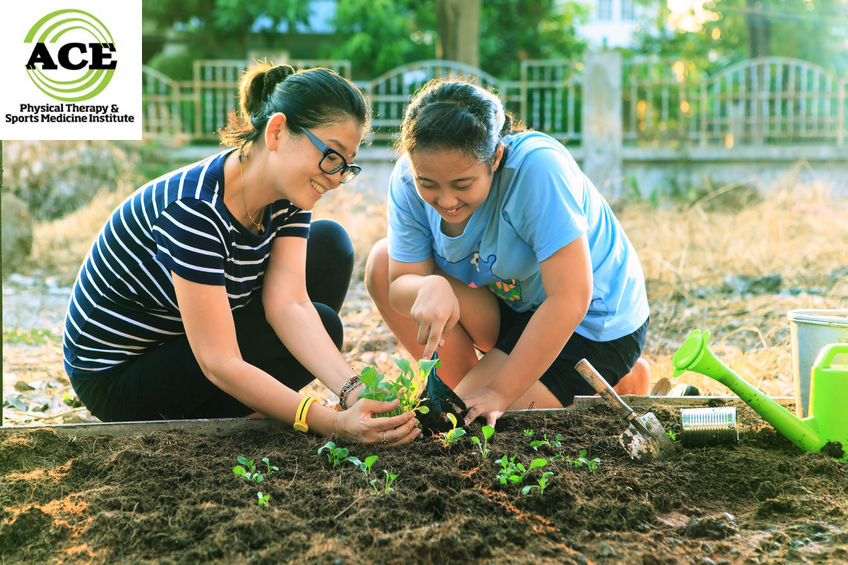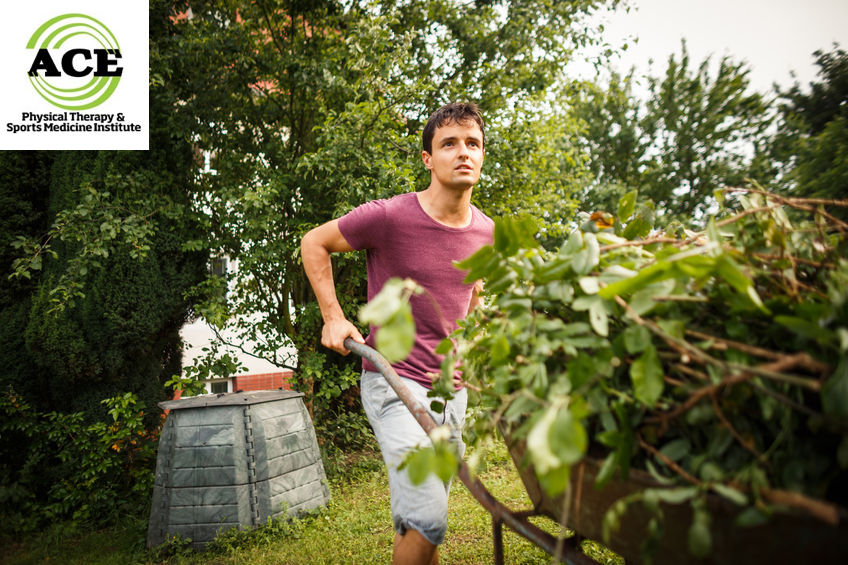WORKING IN THE GARDEN AND PREVENTING INJURY

Tid Bits of Info
- More than 30% of all households in the U.S. have some kind of garden.
- Gardening costs can vary and be as low as $50 or into the thousands.
- Bending at the waist while holding an object in your hands can increase the pressure in lumbar spine disc almost 500%.
- A lot that has mature gardens and trees can have an increase in value of at least 25%.
- If you get injured, seek the advice and treatment of a Physical Therapist.
For many of us, gardening is the perfect way to relax and spend time outdoors. There’s something enriching about getting your hands in the soil, planting plants, and cultivating a garden. This work can be enjoyable, but it can also end up causing pain and even injuries. You can avoid the pain. Learn proper body mechanics and follow a few simple exercises. These can help prepare your body for the workload it will have to handle as you clear and prep your garden for the upcoming growing season.
Obviously, the whole body is involved when someone prepares a garden for the planting and growing season. The movements of squatting, twisting, reaching, lifting and carrying are some motions that can cause injuries to various parts of the body. By exercising the different parts of your body, you can prevent an injury or reduce the severity of the injury if one occurs.
When we move, our bodies are subjected to all kinds of stresses and strains due to the effects of gravity. The primary forces acting on our bodies are compressive and shear force. These forces are needed to help “hold” us together, but too much of either one can create an environment that leads to damage of the joints or soft tissues of the body. The human body relies on two kinds of stability to control the amount of force that occurs within it. There are static and dynamic stabilizing structures in the body. The static stabilizing structures are non-elastic and “leather-like” ligaments, fascia and capsules that surround the joints and muscles. The muscles provide dynamic stabilizing forces to the joints and help to prevent injuries. If these structures are properly prepared and conditioned, they are more capable of protecting the body against injurious forces.
A few simple, do-anywhere exercises can help prepare your body for the upcoming gardening season. Performing the stretches every day and the strengthening exercises every other day will provide you with an exercise routine that should help to prevent injuries and have the body prepared for the gardening season.

Squats: Stand in front of a chair as if you are going to sit down. Your feet should be shoulder width apart. Begin to “sit” down slowly and barely touch your buttocks to the chair seat.
Core strength: The core is every muscle that attaches to the pelvis. This includes the torso muscles and leg muscles. Planks can be performed to help strengthen these muscles.
Planks: Lie prone (on your stomach) and push yourself up off of the floor. Support your body weight on your forearms, elbows, and toes. If it is too hard to support your body weight this way, you may allow your knees to touch the floor. The position should be held for 10-30 seconds or longer.
Side Planks: Lie on one side. Push your body weight up off of the floor and support it with our forearm and elbow on the side where you are lying. If this position is too difficult, keep the entire side of your leg below the knee on the floor during the exercise. Hold the position 10-30 seconds or longer.
Superman: Lie on the floor, face down. Put your arms out to the side at shoulder level. Lift your arms off of the floor and squeeze your shoulder blades together.
Push-ups: The “proper” position is to be prone (face down) on the floor and rise up on your hands and toes. Your elbows are straight and your hands are shoulder-width apart. Lower your body to the floor (don’t touch) and then “push” it back upwards to the starting position. You can modify this exercise by placing your knees on the floor throughout the routine.
Trunk rotations: Lie on your back with your knees bent. Slowly rotate your knees to the floor to one side. Hold the stretch and then rotate to the other side.
Hamstring stretch: Stand in front of a step. Put one heel on the step. Keep that knee straight and lean forward attempting to put your chest on that kneecap.
Walk: Getting you heart “in shape” has to be part of the program. Walk on a regular basis. You should walk fast enough that you have a difficult time holding a conversation. Try to walk for at least 30 minutes 3-4x per week.
In the event that you get injured, seek the treatment and advice of a Physical Therapist. There is no need to visit your doctor first but your insurance policy might require you to have a referral from your primary care physician to go to the Physical Therapist.
Gardening is a popular hobby for a lot of people and if they train themselves properly the chances of getting injured are greatly reduced. This entire exercise routine can be completed in less than ½ hour if you are doing just the exercises. The walk can be done on alternate days if it would fit into your schedule more conveniently.

























This article emphasizes on the importance of static and dynamic stabilizers in the body and their role in protecting against compressive and shearing forces acting on the body. Gardening is one of the outdoor activities that requires movements such as squatting, twisting, reaching, lifting and carrying which can cause injuries to various parts of the body. By learning how to use proper body mechanics and exercising different parts of the body, especially the core muscles, people will be able to avoid injuries to their body or reduce the severity of injuries that may occur during gardening.
If people learn about the importance of using proper body mechanics and the role of exercises on preventing injuries, they will be more protective of their bodies while doing activities such as gardening and will become more motivated on doing the exercises that protects them against injuries.
I found the gardening article to be particularly well timed. My husband and I personally are currently working on getting a vegetable garden going and have had to remove a 200 lb footing. Your article was a good reminder that injuries easily happen in the garden. I have shared your article and am in training to be able to move this footing out of my backyard!
This article is actually useful for the general population regardless of gardening since it puts forth a simple, well balanced, and straightforward approach to exercise that is feasible and functional. The exercise program definitely comes across as achievable. The article covers the basics of any exercise program-cardio (walk), LE strength (squat), back extension (superman), core stability (planks), UE strength (push ups), and rotations – easily allowing for progression.
With gardening in mind the simple squats/sit to stands correlate with the squatting typical of gardening and planks are necessary for core stability that is needed when pulling on nasty weeds or overgrowth (mint!). Table pushups can have an added “plus” to work serratus like when using long pruners to reach tall bushes and limbs and supermans develop back extensors- again for reaching overhead or just getting back into standing after being bent over. Since we don’t move in linear patters rotations are vital to keeping length tension relationships in muscles that allow movement at the arms and legs. Hamstring stretches are excellent because gardening requires quite a bit of bent over positions. Walking is a easy way to get cardio since it’s natural to us (stepping pattern is an actual reflex!) and would also serve to make those muscle stretch out a bit after being crouched or bent over all day with gardening.
Thank you for posting an article that has made me more cognizant of my gardening positions. It has forced me to reflect on if it is appropriate for me to consider certain activities based on my current level of conditioning.
Coming from a family of gardeners I know this time of year is very busy and labor demanding. Between tilling the ground, planting the seeds, and maintaining weeds the physical exertion needed to garden is high. This article helped to shed light that not only athletes or the post surgical individuals are those seeking physical therapy services but anyone could benefit from physical therapy when they have common over use injuries during different seasons. Not only is physical therapy important to educate individuals on proper body mechanics during labor intense activity but also to educate them on the importance of other components of an exercise routine such as stretching and strengthening other areas of the body which some individuals tend to neglect. This article was placed at an excellent time because not only is it early in the gardening season but individuals can read this, reflect, and get the assistance they need to protect their bodies while they continue to enjoy gardening free of pain and limitations.